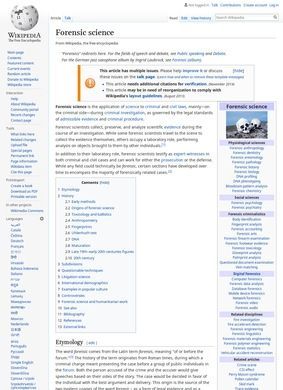Forensic science, as detailed in the comprehensive Wikipedia page, unveils a vast and in-depth domain that merges science with crime detection. Divided into well-structured sections, the platform provides an easy-to-navigate resource for those seeking to delve into the realm of forensic investigation. From etymology and history to subdivisions, questionable techniques, and controversies, the page encompasses all facets of forensic science, providing a complete perspective.
The history section conveys an interesting chronology, detailing the growth and development of forensic science from initial days. It encapsulates information about early scientific methods used in crime-solving, tracing the evolution of various techniques. For instance, it talks about chromatography, toxicology, ballistics, and firearms, anthropology, and more, offering a diverse palate of knowledge. Sub-points include the fundamental Uhlenhuth test and the role of DNA in the maturation of forensic science, among others. It also throws light on key figures that were instrumental in shaping this science in the late 19th to early 20th centuries, rendering an insightful recounting of the past.
The subject of forensic science is further delved into under subdivisions, questionable techniques, and litigation science. This allows readers to gain a multi-faceted understanding of Forensic science. The topic of demographics provides an interesting exploration of the people who make up this field. While media impact sheds light on how forensic science is portrayed in popular culture.
Equipped with a section on controversies, the Wikipedia page provides a holistic view, touching upon not just the merits but also the conflicts associated with forensic science. The portion dedicated to forensic science's role in humanitarian work lends another perspective, adding an additional dash of humaneness to the otherwise technical discipline.
One of the main strengths of the page lies in its universality with a linguistic range of 51 languages, making it accessible to people across different linguistic backgrounds. The available contributions, talk segments, and the option to edit make it interactive and inclusive, encouraging the Wikipedia community to enhance and keep the information updated.
For reference advantage, the page comes packed with a plethora of sources under the references and bibliography sections. Those interested to delve deeper can make use of these resources for extended study. External links provided at the end serve as a bridge to related aspects, helping readers to expand their understanding beyond the page.
In essence, Wikipedia's page on Forensic Science is an informative and comprehensive resource, catering to students, professionals, or anyone intrigued by the science of crime-solving. It encapsulates, not just the essentials, but the many layers and perspectives associated with this intriguing field.
